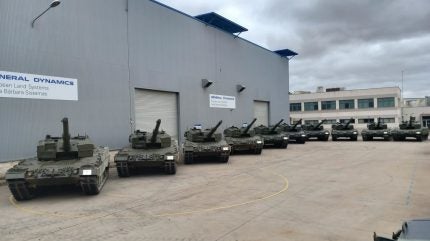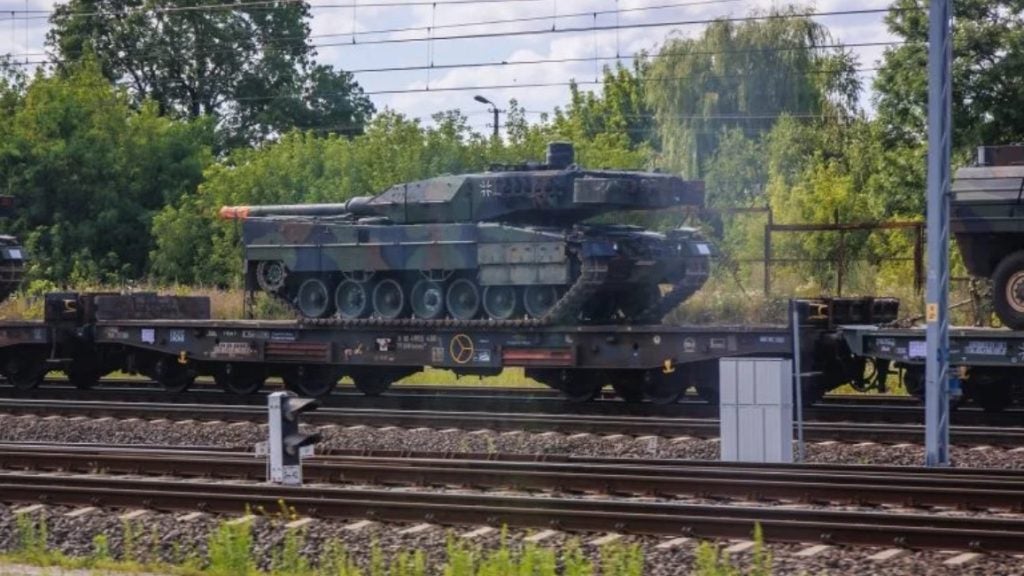
Spain’s Ministry of Defence (MoD) has revealed details of the delivery route that is taking ten refurbished Leopard 2A4 main battle tanks (MBT) to Ukraine, a near-week-long journey by sea through to Poland, before onward transit over the border.
Announcing the planned delivery of the ten MBTs to Ukraine on 15 July 2024, taking Spain’s total number of Leopard 2A4s to Ukraine to 20 vehicles, the Spanish MoD stated that the “multimodal transport” of the tanks had “begun”.
The shipment of ten Leopard 2A4 tanks was accompanied by “various backhoes and a significant number of anti-tank [munitions]”, the Spanish MoD added.
Since Russia’s large-scale invasion in February 2022, Western and Nato allies have sought to provide Ukrainian forces with an ever-increasing range of military platforms, equipment, and ammunition, in a bid to prevent the overthrow of the government of Ukraine’s President Volodymyr Zelensky.
While at first this saw the provision of soldier operated anti-tank and anti-air missile systems, in time the size and capability of donated equipment escalated, reaching the MBT tipping point in early-2023 when the UK committed 14 Challenger 2 tanks.

Since then, Ukraine’s military has benefitted from the provision of a huge range of MBTs, from ex-Soviet design Russian vehicles still operational in old eastern bloc countries, to modern Western platforms such as the US Army’s M1A1 Abrams, the UK’s Challenger 2, or the European Leopard 2.
Analysis carried out by Army Technology calculates that Western Nato members and other allies of Ukraine have provided, pledged, or ordered between 692 to 819 MBTs, ranging from older 105mm-armed Leopard 1 variants and T-72s, to modern Challenger 2 and relatively new M1A1 Abrams.
The lower number donates platforms provided, with the upper number includes those platforms pledged or on order and not yet delivered.
Spain’s Leopard MBTs to travel by sea to Poland
However, despite hundreds of tanks having been delivered to Ukraine over the past two years, the exact transport routes from their various donor countries are not readily disclosed due to security reasons.
It is atypical for a Nato member state to provide exact or indicative timings and methods of delivery of equipment being donated to Ukraine.
While some deliveries are relatively straightforward, such as from countries sharing a border with Ukraine or else neighbouring Poland, other, such as in Spain’s case, require a more complex logistical train.
According to analysis by GlobalData’s Railway Technology outlet, Spain, along with Portugal, operate a different gauge of rail infrastructure (1,668mm) compared to other European countries (1,425mm), which would make a land transport of the Leopard 2A4 tanks from Spain to Poland difficult.
As the gauges change from Spain to France, and onwards through Europe to a delivery destination, the tanks would have to transferred to different size trailers, a lengthy and complex process.

Instead, Spain’s MoD has revealed the exact shipping route the tanks and munitions are taking, having been transported from Seville, where the vehicles were being refurbished at the Santa Bárbara Sistemas factory in Alcalá de Guadaira, to Ferrol, which was carried out “last week”.
Once loaded onto a Ro-Ro vessel for the second phase of delivery, the Leopard 2A4s left Ferrol at “midday on Saturday 13 July”, with the ship “expected to arrive in a Polish port before next weekend”, Spain’s MoD stated on 15 July.
At the higher top-end speed for a commercial Ro-Ro vessel of 16 knots (kt), the 1,584 nautical miles from Ferrol to Gdynia would take four days and three hours, indicating an arrival in Poland at around 15:00 hours on 17 July. At a slower speed of 12kt, the tanks would theoretically arrive at 03:00 hours on 19 July.
Ukraine-bound MBTs receive protection during journey
Once in Poland, the MBTs will begin their “protected land transport” to the point of delivery to the Ukrainian Armed Forces, which will then assume responsibility for the final phase of movement through Ukraine ahead of being made operational.
“Security measures are being taken at all stages of this important movement,” Spain’s MoD stated. “With this new shipment of Leopard 2A4 tanks, Spain has donated a total of 20 of these tanks to Ukraine, with plans to prepare or donate another new set during the second half of 2024.”
Although it is not clear which port on Poland’s coast will be utilised, the infrastructure at Gdynia appears ideally placed to accommodate such large vehicles, offering railheads or road network for onward delivery.
In the east of Poland, it is widely known that the regional airport at Rzeszów is a logistics hub for military equipment deliveries to Ukraine, located some 50km from the border.
Direct rail line connects Poland and Ukraine in the Rzeszów region, with the route crossing the border between the towns of Medyka, Poland, and Shehyni, Ukraine.


